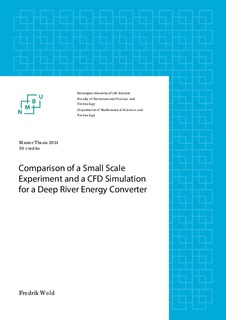| dc.contributor.author | Wold, Fredrik | |
| dc.date.accessioned | 2014-10-20T10:58:18Z | |
| dc.date.available | 2014-10-20T10:58:18Z | |
| dc.date.copyright | 2014 | |
| dc.date.issued | 2014-10-20 | |
| dc.identifier.uri | http://hdl.handle.net/11250/224164 | |
| dc.description | Masteroppgaven dekker gjennomføringen av et små skala eksperiment gjennomført i en bølgetank. En CFD simulering ble gjennomført, og modellen som ble simulert var forsøkt konstruert slik som systemet hvor eksperimentet ble gjennomført. Resultatene fra eksperimentet og simuleringen ble tilslutt sammenlignet. | nb_NO |
| dc.description.abstract | Deep River AS(Drøbak, Norway) have developed a water current turbine for river, tidal and ocean currents. The turbine is designed to convert the kinetic energy in the water into green renewable electric energy for grid or off-grid systems. The company have signed a contract of interest with the Lithuanian Inland Waterways Authorities. The contract states that if the prototype performs within the expectations there will be a renewed contract with a purchase of 100 turbines. The contract is worth NOK 350 mill.
Before Deep River conducts a prototype test (August 2014) there have previously been
performed a series of experiments and simulations to get proof of concept.
This thesis covers the planning, performance and analysis of a small scale experiment,
and a computational fluid dynamics (CFD) simulation. In the interest of comparing the
experiment with the simulation was the simulated system modelled after the experimental system.
The experiment where performed on the Deep River small scale turbine in a wave tank.
The wave tank was installed with equipment for generating continuous flow. There were
a number of computer programs used to prepare, run, and process the results of the CDF
simulation;
• SolidWorks
• ANSYS Workbench
• ANSYS DesignModeler
• ANSYS Mesh
• ANSYS CFX-pre
• ANSYS CFX
• ANSYS CFX-post
SolidWorks and DesignModeler was used for model preparation. ANSYS Workbench
was used to simplify the cooperation between the ANSYS programs. The mesh settings
were set and generated in ANSYS Mesh. CFX-pre was the used pre-processor where all the conditions for the system was set. CFX solved the iteration upon the mesh, and the results were graphically processed in CFX-post.
The experimental setup required a contraption that could evenly spread the flow, even
when it had to go through an expansion from a 100 mm to a 300 mm diameter pipe and
through a 90 degree bend. A pump nozzle was designed and constructed to fill this purpose.
The experiment and simulation was found to have significant differences in their systems,
and for that reason was not directly comparable. This made it difficult to draw conclusions from the experiment and CFD simulation. | nb_NO |
| dc.description.sponsorship | Deep River AS | nb_NO |
| dc.language.iso | eng | nb_NO |
| dc.publisher | Norwegian University of Life Sciences, Ås | |
| dc.subject | CFD | nb_NO |
| dc.subject | Simulation | nb_NO |
| dc.subject | Experiment | nb_NO |
| dc.subject | River Current Turbine | nb_NO |
| dc.title | Comparison of a small scale experiment and a CFD simulation of a Deep River Energy Converter | nb_NO |
| dc.type | Master thesis | nb_NO |
| dc.subject.nsi | VDP::Technology: 500::Electrotechnical disciplines: 540::Electrical power engineering: 542 | nb_NO |
| dc.source.pagenumber | 91 | nb_NO |
| dc.description.localcode | M-MF | nb_NO |
